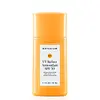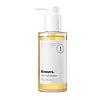What's inside
What's inside
 Key Ingredients
Key Ingredients

 Benefits
Benefits

 Concerns
Concerns

 Ingredients Side-by-side
Ingredients Side-by-side

Butyl Methoxydibenzoylmethane 3%
UV AbsorberHomosalate 10%
Skin ConditioningEthylhexyl Salicylate 5%
UV AbsorberWater
Skin ConditioningIsododecane
EmollientPolymethyl Methacrylate
Butyloctyl Salicylate
Skin ConditioningAcrylates Copolymer
Saccharomyces Ferment
Skin ConditioningAluminum Starch Octenylsuccinate
AbsorbentButylene Glycol
HumectantPolyglyceryl-6 Polyricinoleate
EmulsifyingC24-28 Alkyldimethylsiloxy Trimethylsiloxysilicate
Skin ProtectingPolyglyceryl-2 Dipolyhydroxystearate
Skin ConditioningDisteardimonium Hectorite
StabilisingSodium Chloride
MaskingCaesalpinia Spinosa Fruit Extract
Skin ProtectingHelianthus Annuus Sprout Extract
Skin ConditioningSodium Stearoyl Glutamate
CleansingGlycine Soja Oil
EmollientSqualane
EmollientRaspberry Ketone
MaskingLauroyl Lysine
Skin ConditioningCaprylyl/Capryl Glucoside
CleansingTriethyl Citrate
MaskingPolyglyceryl-10 Dioleate
EmulsifyingHydroxyethylcellulose
Emulsion StabilisingOctyldodecanol
EmollientTocopherol
AntioxidantSodium Phytate
Polysorbate 60
EmulsifyingDisodium Phosphate
BufferingSodium Phosphate
BufferingSodium Benzoate
MaskingCaprylyl Glycol
EmollientPropylene Glycol
HumectantCitric Acid
BufferingPhenoxyethanol
PreservativeButyl Methoxydibenzoylmethane 3%, Homosalate 10%, Ethylhexyl Salicylate 5%, Water, Isododecane, Polymethyl Methacrylate, Butyloctyl Salicylate, Acrylates Copolymer, Saccharomyces Ferment, Aluminum Starch Octenylsuccinate, Butylene Glycol, Polyglyceryl-6 Polyricinoleate, C24-28 Alkyldimethylsiloxy Trimethylsiloxysilicate, Polyglyceryl-2 Dipolyhydroxystearate, Disteardimonium Hectorite, Sodium Chloride, Caesalpinia Spinosa Fruit Extract, Helianthus Annuus Sprout Extract, Sodium Stearoyl Glutamate, Glycine Soja Oil, Squalane, Raspberry Ketone, Lauroyl Lysine, Caprylyl/Capryl Glucoside, Triethyl Citrate, Polyglyceryl-10 Dioleate, Hydroxyethylcellulose, Octyldodecanol, Tocopherol, Sodium Phytate, Polysorbate 60, Disodium Phosphate, Sodium Phosphate, Sodium Benzoate, Caprylyl Glycol, Propylene Glycol, Citric Acid, Phenoxyethanol
Water
Skin ConditioningCoco-Betaine
CleansingDecyl Glucoside
CleansingOlea Europaea Fruit Oil
MaskingGlycerin
HumectantSodium Chloride
MaskingSucrose
HumectantSodium Hydroxide
BufferingCitric Acid
BufferingCaprylyl Glycol
Emollient1,2-Hexanediol
Skin ConditioningCitrus Sinensis Peel Oil Expressed
PerfumingOriganum Majorana Leaf Oil
MaskingLavandula Angustifolia Oil
MaskingZanthoxylum Piperitum Fruit Extract
Skin ConditioningUsnea Barbata Extract
Pulsatilla Koreana Extract
Skin ConditioningBetaine
HumectantHoney Extract
HumectantSodium Phytate
Anthemis Nobilis Flower Oil
MaskingPelargonium Graveolens Leaf Oil
Simmondsia Chinensis Seed Oil
EmollientPrunus Armeniaca Kernel Oil
MaskingCannabis Sativa Seed Oil
EmollientBrassica Oleracea Italica Seed Oil
EmollientAlcohol
AntimicrobialLimonene
PerfumingLinalool
PerfumingWater, Coco-Betaine, Decyl Glucoside, Olea Europaea Fruit Oil, Glycerin, Sodium Chloride, Sucrose, Sodium Hydroxide, Citric Acid, Caprylyl Glycol, 1,2-Hexanediol, Citrus Sinensis Peel Oil Expressed, Origanum Majorana Leaf Oil, Lavandula Angustifolia Oil, Zanthoxylum Piperitum Fruit Extract, Usnea Barbata Extract, Pulsatilla Koreana Extract, Betaine, Honey Extract, Sodium Phytate, Anthemis Nobilis Flower Oil, Pelargonium Graveolens Leaf Oil, Simmondsia Chinensis Seed Oil, Prunus Armeniaca Kernel Oil, Cannabis Sativa Seed Oil, Brassica Oleracea Italica Seed Oil, Alcohol, Limonene, Linalool
Ingredients Explained
These ingredients are found in both products.
Ingredients higher up in an ingredient list are typically present in a larger amount.
Caprylyl Glycol is a humectant and emollient, meaning it attracts and preserves moisture.
It is a common ingredient in many products, especially those designed to hydrate skin. The primary benefits are retaining moisture, skin softening, and promoting a healthy skin barrier.
Though Caprylyl Glycol is an alcohol derived from fatty acids, it is not the kind that can dry out skin.
This ingredient is also used as a preservative to extend the life of products. It has slight antimicrobial properties.
Learn more about Caprylyl GlycolCitric Acid is an alpha hydroxy acid (AHA) naturally found in citrus fruits like oranges, lemons, and limes.
Like other AHAs, citric acid can exfoliate skin by breaking down the bonds that hold dead skin cells together. This helps reveal smoother and brighter skin underneath.
However, this exfoliating effect only happens at high concentrations (20%) which can be hard to find in cosmetic products.
Due to this, citric acid is usually included in small amounts as a pH adjuster. This helps keep products slightly more acidic and compatible with skin's natural pH.
In skincare formulas, citric acid can:
While it can provide some skin benefits, research shows lactic acid and glycolic acid are generally more effective and less irritating exfoliants.
Most citric acid used in skincare today is made by fermenting sugars (usually from molasses). This synthetic version is identical to the natural citrus form but easier to stabilize and use in formulations.
Read more about some other popular AHA's here:
Learn more about Citric AcidChances are, you eat sodium chloride every day. Sodium Chloride is also known as table salt.
This ingredient has many purposes in skincare: thickener, emulsifier, and exfoliator.
You'll most likely find this ingredient in cleansers where it is used to create a gel-like texture. As an emulsifier, it also prevents ingredients from separating.
There is much debate on whether this ingredient is comedogenic. The short answer - comedogenic ratings don't tell the whole story. Learn more about comegodenic ratings here.
The concensus about this ingredient causing acne seems to be divided. Research is needed to understand if this ingredient does cause acne.
Scrubs may use salt as the primary exfoliating ingredient.
Learn more about Sodium ChlorideSodium Phytate is the synthetic salt form of phytic acid. Phytic acid is an antioxidant and can be found in plant seeds.
Sodium Phytate is a chelating agent. Chelating agents help prevent metals from binding to water. This helps stabilize the ingredients and the product.
Water. It's the most common cosmetic ingredient of all. You'll usually see it at the top of ingredient lists, meaning that it makes up the largest part of the product.
So why is it so popular? Water most often acts as a solvent - this means that it helps dissolve other ingredients into the formulation.
You'll also recognize water as that liquid we all need to stay alive. If you see this, drink a glass of water. Stay hydrated!
Learn more about Water